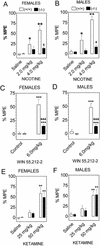A pervasive mechanism for analgesia: activation of GIRK2 channels
- PMID: 12493843
- PMCID: PMC140950
- DOI: 10.1073/pnas.012682399
A pervasive mechanism for analgesia: activation of GIRK2 channels
Abstract
G protein-coupled inwardly rectifying potassium channels (GIRKs) provide a common link between numerous neurotransmitter receptors and the regulation of synaptic transmission. We asked whether GIRKs specify a single behavioral action that is produced by drugs acting on the diverse receptors coupled with GIRKs. By using GIRK2-null mutant mice, we found marked reduction or complete elimination of the antinociceptive (hot plate test) effects of ethanol, oxotremorine, nicotine, baclofen, clonidine, and the cannabinoid receptor agonist WIN 55,212. However, ketamine analgesia remained intact. For most drugs, there was a sex difference in antinociceptive action, and the impact of deletion of the GIRK2 channel was less in female mice. The deletion of the GIRK2 channel blocks the opioid-dependent component of stress-induced analgesia (SIA), whereas nonopioid SIA was not changed. We propose that opioid, alpha adrenergic, muscarinic cholinergic, gamma-aminobutyric acid-B, and cannabinoid receptors are coupled with postsynaptic GIRK2 channels in vivo. Furthermore, this pathway accounts for essentially all of the antinociceptive effects in males, although females appear to recruit additional signal transduction mechanisms for some analgesic drugs.
Figures




References
-
- Vaughan C W, Ingram S L, Connor M A, Christie M J. Nature. 1997;390:611–614. - PubMed
-
- Vaughan C W, Connor M, Bagley E E, Christie M J. Mol Pharmacol. 2000;57:288–295. - PubMed
-
- Ikeda K, Kobayashi T, Kumanishi T, Niki H, Yano R. Neurosci Res. 2000;38:113–116. - PubMed
-
- Kobayashi T, Ikeda K, Kojima H, Niki H, Yano R, Yoshioka T, Kumanishi T. Nat Neurosci. 1999;2:1091–1097. - PubMed
-
- Patil N, Cox D R, Bhat D, Faham M, Peterson A S. Nat Genet. 1995;11:126–129. - PubMed
Publication types
MeSH terms
Substances
Grants and funding
LinkOut - more resources
Full Text Sources
Other Literature Sources
Medical
Molecular Biology Databases
Miscellaneous

